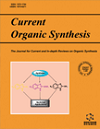- Home
- A-Z Publications
- Current Organic Synthesis
- Previous Issues
- Volume 7, Issue 2, 2010
Current Organic Synthesis - Volume 7, Issue 2, 2010
Volume 7, Issue 2, 2010
-
-
Recent Multiple Transition Metal Catalysed Single-Pot Reactions
More LessAuthors: Anthony J. Burke, Vanda R. Marinho and Olivia M.R. FurtadoOver the last several years the need to improve efficiency and minimize waste has spurred chemists to develop new catalysts for a wider range of reactions that was previously only achievable using stoichiometric reagents. A very powerful approach at achieving this goal is through the use of multiple transition metal catalysed one-pot processes, whereby the desired target compound is synthesised in a single work-up step. In t Read More
-
-
-
(Masked)serinols: Molecules, Biomolecules, Building-Blocks, Supramolecules.Part (I): Syntheses Based on Serinols' Reactivity with Carbonyl Electrophiles
More LessSince the period of the 1940's, 2-aminopropane-1,3-diol (“serinol”) and its commercial C-substituted analogous are a popular motif in organic compounds covering almost all facets of organic synthesis. This first part of the review deals mainly with the nowadays approaches focused on serinols'reactivity with carbonyl electrophiles (aldehydes and ketones) as well as its applications.
-
-
-
Formation of Five- and Six-Membered Heterocyclic Compounds by Ringclosing Metathesis
More LessAuthors: K. C. Majumdar, Buddhadeb Chattopadhyay and Krishanu RayThis brief review article describes the progress made in the synthesis of five- and six-membered heterocyclic rings by the application of the ring-closing metathesis reactions during the period of 2007-2008.
-
-
-
Streamlining Organic Free Radical Synthesis through Modern Molecular Technology: from Polymer Supported Synthesis to Microreactors and Beyond
More LessAuthors: Shengmiao Zhang, Jianding Chen, Ioannis N. Lykakis and V. T. PerchyonokIncreasing emphasis has been placed on producing synthetic organic compounds faster and more efficiently than can be produced using conventional methodology. It is often observed that tried and true methods for performing synthesis, work-up, and purification on individual or low number of reactions do not scale up well even to a modest level of parallel synthesis. As a result, novel methodologies or parallel and co Read More
-
Volumes & issues
-
Volume 22 (2025)
-
Volume 21 (2024)
-
Volume 20 (2023)
-
Volume 19 (2022)
-
Volume 18 (2021)
-
Volume 17 (2020)
-
Volume 16 (2019)
-
Volume 15 (2018)
-
Volume 14 (2017)
-
Volume 13 (2016)
-
Volume 12 (2015)
-
Volume 11 (2014)
-
Volume 10 (2013)
-
Volume 9 (2012)
-
Volume 8 (2011)
-
Volume 7 (2010)
-
Volume 6 (2009)
-
Volume 5 (2008)
-
Volume 4 (2007)
-
Volume 3 (2006)
-
Volume 2 (2005)
-
Volume 1 (2004)
Most Read This Month
Article
content/journals/cos
Journal
10
5
false
en


